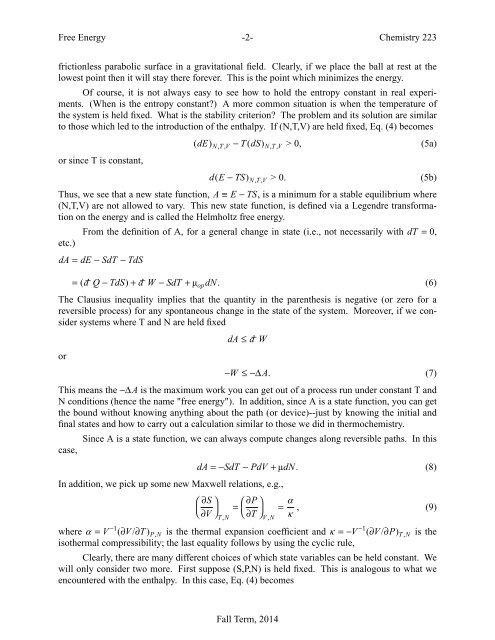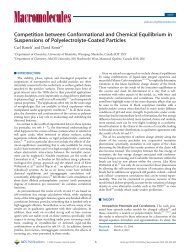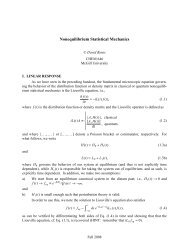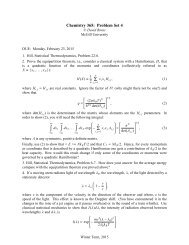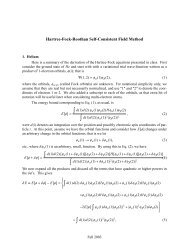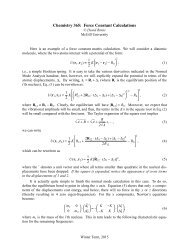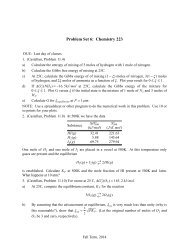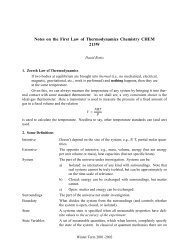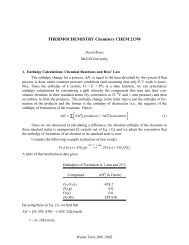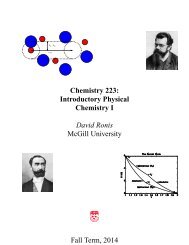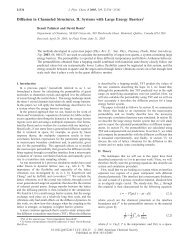Thermodynamic Stability: Free Energy and ... - McGill University
Thermodynamic Stability: Free Energy and ... - McGill University
Thermodynamic Stability: Free Energy and ... - McGill University
You also want an ePaper? Increase the reach of your titles
YUMPU automatically turns print PDFs into web optimized ePapers that Google loves.
<strong>Free</strong> <strong>Energy</strong> -2- Chemistry 223frictionless parabolic surface in a gravitational field. Clearly, ifweplace the ball at rest at thelowest point then it will stay there forever. This is the point which minimizes the energy.Of course, it is not always easy to see how tohold the entropy constant in real experiments.(When is the entropy constant?) A more common situation is when the temperature ofthe system is held fixed. What is the stability criterion? The problem <strong>and</strong> its solution are similarto those which led to the introduction of the enthalpy. If(N,T,V) are held fixed, Eq. (4) becomesor since T is constant,(dE) N,T ,V − T (dS) N,T ,V >0,d(E − TS) N,T ,V >0.Thus, we see that a new state function, A ≡ E − TS, isaminimum for a stable equilibrium where(N,T,V) are not allowed to vary. This new state function, is defined via a Legendre transformationon the energy <strong>and</strong> is called the Helmholtz free energy.etc.)From the definition of A, for a general change in state (i.e., not necessarily with dT = 0,dA = dE − SdT − TdS= (d − Q − TdS) + d − W − SdT + µ op dN. (6)The Clausius inequality implies that the quantity in the parenthesis is negative (or zero for areversible process) for any spontaneous change in the state of the system. Moreover, if weconsidersystems where T <strong>and</strong> N are held fixedordA ≤ d − W(5a)(5b)−W ≤−∆A. (7)This means the −∆A is the maximum work you can get out of a process run under constant T <strong>and</strong>Nconditions (hence the name "free energy"). In addition, since A is a state function, you can getthe bound without knowing anything about the path (or device)--just by knowing the initial <strong>and</strong>final states <strong>and</strong> how tocarry out a calculation similar to those we did in thermochemistry.case,Since A is a state function, we can always compute changes along reversible paths. In thisIn addition, we pick up some new Maxwell relations, e.g.,dA =−SdT − PdV + µdN. (8)⎛ ∂S ⎞= ⎛ ∂P ⎞= α ⎝ ∂V ⎠ T ,N⎝ ∂T ⎠ V ,Nκ , (9)where α = V −1 (∂V /∂T ) P,N is the thermal expansion coefficient <strong>and</strong> κ =−V −1 (∂V /∂P) T ,N is theisothermal compressibility; the last equality follows by using the cyclic rule,Clearly, there are many different choices of which state variables can be held constant. Wewill only consider two more. First suppose (S,P,N) is held fixed. This is analogous to what weencountered with the enthalpy. Inthis case, Eq. (4) becomesFall Term, 2014


